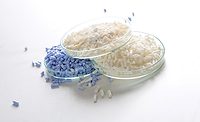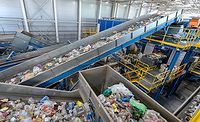How Can Adhesives and Sealants Improve Equipment Reliability?
When implemented correctly, adhesives and sealants can play a critical role in improving equipment reliability and lowering maintenance and operational costs.

Adhesives and sealants are an essential component of every equipment maintenance and reliability plan. With rapidly developing technologies and products, businesses need to stay on top of these trends. When implemented correctly, adhesives and sealants can play a critical role in improving equipment reliability and lowering maintenance and operational costs.
Depending on the exact type of adhesive or sealant, end uses can stretch from equipment repairs and sealing leaks to bonding materials and locking threaded fasteners. Through the planned and selective application of adhesives and sealants, businesses can protect their assets and equipment from wear, damage, and corrosion. The results include extended service life, reduced incidents of catastrophic failure, and significant savings on operating and maintenance costs in the form of reduced unscheduled downtime and increased mean time between failures (MTBF).1
Component Protection
The correct application of sealants can play a critical role in component and equipment protection and is often credited as part of an organization’s asset management and reliability plans. External forces such as vibration, shock, and thermal expansion and contraction can all cause threaded fasteners like screws and bolts to loosen over time and lead to catastrophic fatigue failure and lengthy system downtimes.
Threadlocking sealants or machinery adhesives are widely used in the utilities industry to prevent this phenomenon of vibration loosening. Self-curing sealants and adhesives are placed into the joint to fill the machining tolerances and produce a solid filler. This addresses the failure root cause by significantly reducing the empty spaces in the threaded assembly. The sealants and adhesives also act as a lubricant during the assembly process by removing the inherent variability that occurs when tightening as-received fasteners.
Composite threadsealants can also inhibit chemical attack and galvanic corrosion. These products create a sacrificial and renewable working surface, thereby maintaining the structural integrity of the original substrate.
Threadlocking and threadsealing applications typically call for higher temperatures, higher pressures, and resistance to harsher process fluids. Many product lines are available to address specific technical needs. These methods of equipment protection can help maximize the reliability and efficiency of plant processes and equipment.
Leak Prevention
Leaks represent one of the most common maintenance reliability challenges for fluid and pneumatic systems. Failure areas are typically flanged and threaded fitting configurations, which can often be proactively countered with specific types of flange and thread sealants.
The application of these anaerobic sealants is an inexpensive and reliable method of ensuring that threaded assemblies remain locked and leak-proof for their designed service life. The sealants are applied to the threads of a bolt as a liquid, stick, or even as a tape that fills the thread grooves and cures into a hard thermoset material when it is exposed to metal ions in the absence of air.
These sealants can be applied in addition to gaskets for a leak-tight configuration on flanged joints with metal-to-metal contact, or even by themselves (e.g., liquid gaskets). This ensures that mating parts ultimately act as one conjoined unit under system pressure, preventing leaks that can cause costly downtime.
Leak Mitigation
In situations where leaks have already developed, sealants can often provide a quick fix without requiring equipment downtime for both hydraulic and pneumatic systems. On the other hand, multiple small leaks can accumulate and cause excessive equipment load as well as added energy losses on an aggregate level (as with a compressed air system, for example).
While a certain amount of leakage used to be acceptable in the industry in the recent past, it is less tolerated in today’s competitive marketplace. Quick-curing sealants and industrial-grade adhesives not only improve equipment reliability but also help protect brand reputation, lower energy costs, reduce housekeeping resources, and improve competitive advantage.

Maintenance Planning with CMMS
An effective computerized maintenance management system (CMMS) can help in the application of sealants and adhesives to optimize equipment reliability.
Central Source of Information
Routine applications of adhesives and sealants can be effectively implemented through the use of a CMMS that enables informed decision making by using a single standardized data source as the baseline for maintenance practices.
Continuous Improvement
The central CMMS database with a comprehensive maintenance history can help maintenance teams review maintenance history, as well as as-found, as-left conditions that are vital to sound reliability decision making. This serves as the backbone of a continuous improvement framework, as teams can leverage the lessons learned and improve with additional time and data.
Documentation such as repair manuals, maintenance procedures, and even videos capturing maintenance procedures can be stored within the CMMS and linked to corresponding end devices or equipment. Storing this knowledge domain helps develop consistency and excellence in maintenance workmanship. It also preserves the knowledge to be transferred to new personnel rather than letting it walk out the door with inevitable staff turnover and attrition.
Inventory Management
A CMMS helps store bills of materials (BOM) and OEM information with the recommended adhesives and sealants, ensuring that the applications are technically sound and tested. In addition, CMMS can offer inventory management functionality by tracking usage and availability and ensuring proactive procurement triggers are sent to supply chain teams to either meet upcoming scheduled maintenance activities or maintain a minimum inventory on hand.
Time Management
Good planning and scheduling can increase maintenance productivity by as much as 65%,2 meaning the maintenance team can spend their time on more critical work, or better yet, enable the business to save on required maintenance resources and costs. In addition, a CMMS can also offer the functionality to schedule work with both short- and long-term projections per resource crew, which may be relevant for larger facilities with specialty maintenance crews.
Implementing the Toolkit
Adhesives and sealants are a valuable addition to any maintenance team’s toolkit and can have a broad range of applications targeted toward equipment failure risk mitigation. A CMMS can play a vital multi-pronged role in the effective implementation of this toolkit.
For more information, visit www.limblecmms.com.
Note: Opening image courtesy of NicoElNino via iStock/Getty Images Plus.
References
- Christiansen, Bryan, “MTTR, MTBF, or MTTF? A Simple Guide To Failure Metrics,” August 10, 2018, https://limblecmms.com/blog/mttr-mtbf-mttf-guide-to-failure-metrics.
- Midas, Matt, “Best Practices of Maintenance Planning & Scheduling,” Inspectioneering Journal, March/April 2015, https://inspectioneering.com/journal/2015-04-21/4543/best-practices-of-maintenance-.
Looking for a reprint of this article?
From high-res PDFs to custom plaques, order your copy today!









